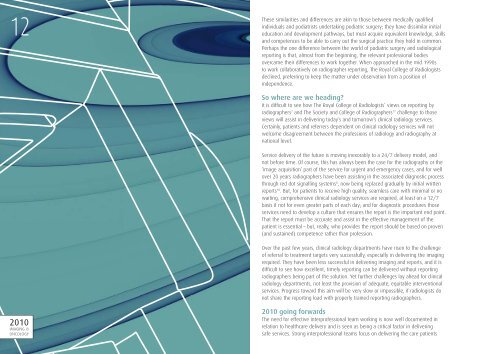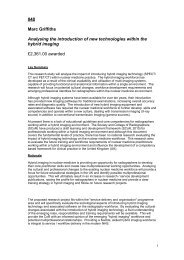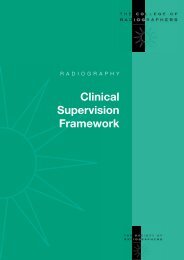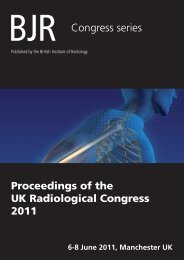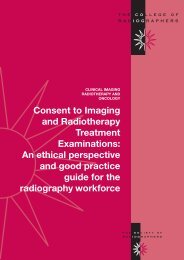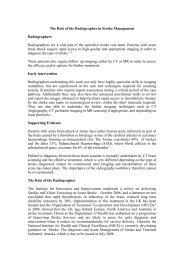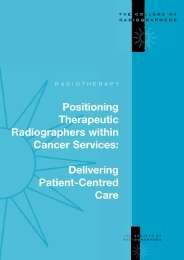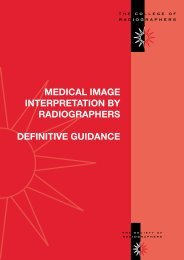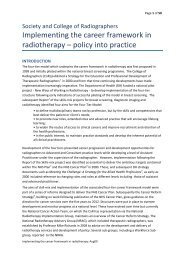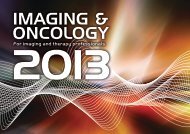IMAGING & ONCOLOGY - Society of Radiographers
IMAGING & ONCOLOGY - Society of Radiographers
IMAGING & ONCOLOGY - Society of Radiographers
- No tags were found...
Create successful ePaper yourself
Turn your PDF publications into a flip-book with our unique Google optimized e-Paper software.
12These similarities and differences are akin to those between medically qualifi edindividuals and podiatrists undertaking podiatric surgery; they have dissimilar initialeducation and development pathways, but must acquire equivalent knowledge, skillsand competences to be able to carry out the surgical practice they hold in common.Perhaps the one difference between the world <strong>of</strong> podiatric surgery and radiologicalreporting is that, almost from the beginning, the relevant pr<strong>of</strong>essional bodiesovercame their differences to work together. When approached in the mid 1990sto work collaboratively on radiographer reporting, The Royal College <strong>of</strong> Radiologistsdeclined, preferring to keep the matter under observation from a position <strong>of</strong>independence.So where are we heading?It is diffi cult to see how The Royal College <strong>of</strong> Radiologists’ views on reporting byradiographers 7 and The <strong>Society</strong> and College <strong>of</strong> <strong>Radiographers</strong> 17 challenge to thoseviews will assist in delivering today’s and tomorrow’s clinical radiology services.Certainly, patients and referrers dependent on clinical radiology services will notwelcome disagreement between the pr<strong>of</strong>essions <strong>of</strong> radiology and radiography atnational level.Service delivery <strong>of</strong> the future is moving inexorably to a 24/7 delivery model, andnot before time. Of course, this has always been the case for the radiography or the‘image acquisition’ part <strong>of</strong> the service for urgent and emergency cases, and for wellover 20 years radiographers have been assisting in the associated diagnostic processthrough red dot signalling systems 8 , now being replaced gradually by initial writtenreports 18 . But, for patients to receive high quality, seamless care with minimal or nowaiting, comprehensive clinical radiology services are required, at least on a 12/7basis if not for even greater parts <strong>of</strong> each day; and for diagnostic procedures thoseservices need to develop a culture that ensures the report is the important end point.That the report must be accurate and assist in the effective management <strong>of</strong> thepatient is essential – but, really, who provides the report should be based on proven(and sustained) competence rather than pr<strong>of</strong>ession.Over the past few years, clinical radiology departments have risen to the challenge<strong>of</strong> referral to treatment targets very successfully, especially in delivering the imagingrequired. They have been less successful in delivering imaging and reports, and it isdiffi cult to see how excellent, timely reporting can be delivered without reportingradiographers being part <strong>of</strong> the solution. Yet further challenges lay ahead for clinicalradiology departments, not least the provision <strong>of</strong> adequate, equitable interventionalservices. Progress toward this aim will be very slow or impossible, if radiologists donot share the reporting load with properly trained reporting radiographers.2010<strong>IMAGING</strong> &<strong>ONCOLOGY</strong>2010 going forwardsThe need for effective interpr<strong>of</strong>essional team working is now well documented inrelation to healthcare delivery and is seen as being a critical factor in deliveringsafe services. Strong interpr<strong>of</strong>essional teams focus on delivering the care patients


